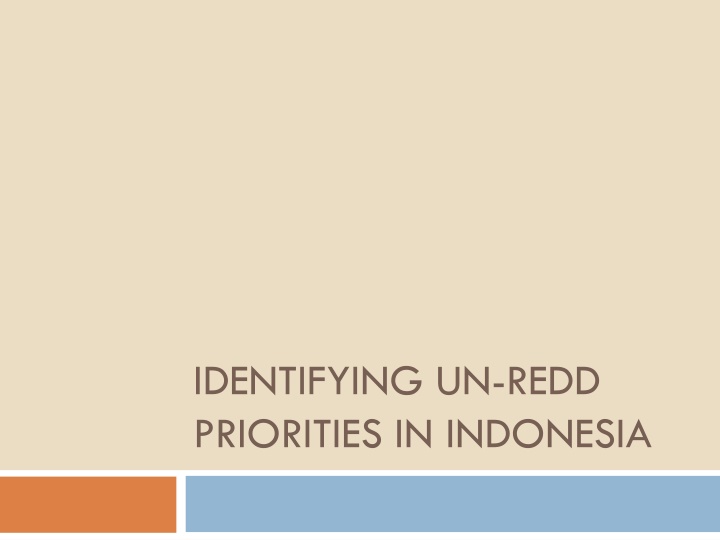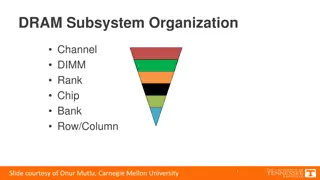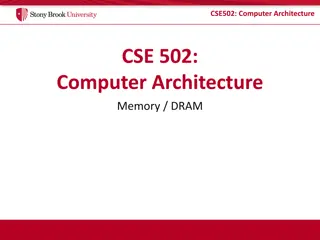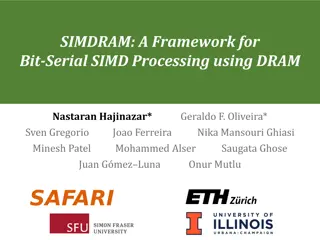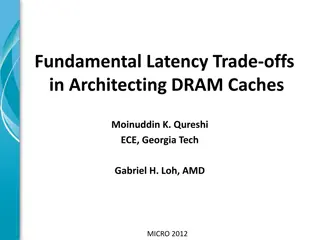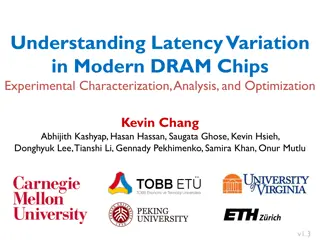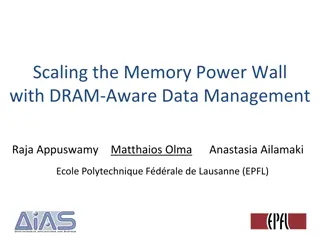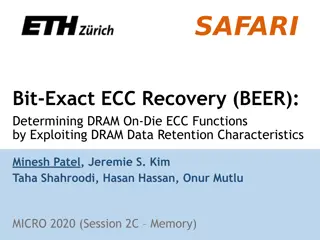Exploiting DRAM Data Retention Characteristics
DRAM research focuses on Bit-Exact ECC Recovery (BEER) to determine on-die ECC functions, operating timings, temperature dependence, aggregate failure rates, chip reliability, error distributions, inter-chip variation, and ECC obfuscation. BEER methodology induces errors to solve parity-check matrices without special hardware. Experimental demo involves LPDDR4 DRAM chips from major manufacturers. Observations include different parity-check matrices usage among manufacturers, BEER's effectiveness, and testing challenges posed by on-die ECC.
Download Presentation

Please find below an Image/Link to download the presentation.
The content on the website is provided AS IS for your information and personal use only. It may not be sold, licensed, or shared on other websites without obtaining consent from the author.If you encounter any issues during the download, it is possible that the publisher has removed the file from their server.
You are allowed to download the files provided on this website for personal or commercial use, subject to the condition that they are used lawfully. All files are the property of their respective owners.
The content on the website is provided AS IS for your information and personal use only. It may not be sold, licensed, or shared on other websites without obtaining consent from the author.
E N D
Presentation Transcript
IDENTIFYING UN-REDD PRIORITIES IN INDONESIA
Step 1: Scoping Mission Scoping Mission - Nov. 2008 Meetings with all stakeholder groups Discussions on harmonization with WB
Step 2: Post-Scoping Mission Gaps analysis Support services to MoF Development of Draft 0
Step 3: Formulation Mission Formulation Mission - Feb. 2009 Discussions with MoF and other stakeholder groups Harmonization with R-PLAN Development of JPD for submission to UN-REDD Policy Board
Draft project structure Objective of UN-REDD Programme in Indonesia: To assist the GoI in attaining REDD-readiness
Outcomes Outcome 1: Strengthened multi-stakeholder participation at national level Outcome 2: Successful provincial demonstration of establishing MARV and fair payment systems based on the national REDD architecture Outcome 3: Capacity established to implement REDD at decentralized levels
1: Strengthened multi-stakeholder participation at national level Output 1.1 Consensus on key-issues for REDD policy development Organize national and sub-national consultations on key-issues, including inter- ministerial round table discussions Analyze key issues identified by stakeholders to streamline the REDD value chain Prepare policy recommendations Develop roadmap for issuing policies to address these issues
1: Strengthened multi-stakeholder participation at national level Output 1.1 Consensus on key-issues for REDD policy development Output 1.2 Communications and knowledge exchange programme Conducting awareness baseline assessment; Design of social marketing campaign, specifically focusing on high level government decision makers; Engage with existing REDD projects to analyze lessons (particularly related to issues of poverty) Develop REDD Information, Education and Communication materials National knowledge & learning platform established Conduct training on REDD
2: Successful provincial demonstration of MARV and fair payment systems Output 2.1 Improved Capacity to capture REDD elements within MARV Organization of a seminar at provincial level Identification and assessment of capacity building needs and feasibility for MARV at the provincial level Training of staff of provincial institutions in implementation of MARV system Mobilization of technical support for designing scalable NFI sampling scheme and standards. Demonstration and formulation of standards for the estimation of carbon storage and temporal change
2: Successful provincial demonstration of MARV and fair payment systems Output 2.1 Improved Capacity to capture REDD elements within MARV Output 2.2 Reference emissions level (REL) established Review of methodologies for establishing scenario/baseline at a provincial level Awareness raising of purpose of REL and calculation methodology Compilation of data to support establishment of the REL Establishment of a provisional Baseline and Reference emissions level (REL) Stakeholder consultations on provisional REL Scientific peer review of provisional REL Establishment of revised REL Dissemination of REL information
2: Successful provincial demonstration of MARV and fair payment systems Output 2.1 Improved Capacity to capture REDD elements within MARV Output 2.2 Reference emissions level (REL) established Output 2.3 Harmonized fair and equitable payment mechanism at provincial level Compilation of information on existing payment systems Analysis and review of benefits and constraints of existing payment systems Formulation of options for modifications required to meet requirements of a REDD payment system Stakeholder consultations on proposed modifications Integration of modifications to create a REDD payment system Pilot payment system with seed money Training of staff of local institutions on application of modifications to the payment system
2: Successful provincial demonstration of MARV and fair payment systems Output 2.1 Improved Capacity to capture REDD elements within MARV Output 2.2 Reference emissions level (REL) established Output 2.3 Harmonized fair and equitable payment mechanism at provincial level Output 2.4 Toolkit for priority setting Development and testing of the Priority Setting Toolkit Training of provincial staff of BAPLA, BAPPEDA and others in its use; Mapping of above- and below-ground carbon stocks inside and outside the Forest Estate at provincial level; Overlay mapping to incorporate co-benefits into the planning products and produce GIS maps
3: Capacity established to implement REDD at decentralized levels Output 3.1 Capacity for spatial socio-economic planning incorporating REDD at the district level Identify areas of REDD-eligible forest Analyse opportunity costs of alternative land uses Mainstream REDD into existing spatial planning and forest utilization planning Develop district based consensus on land and forest use allocation Approve the REDD mainstreamed spatial plan.
3: Capacity established to implement REDD at decentralized levels Output 3.1 Capacity for spatial socio-economic planning incorporating REDD at the district level Output 3.2 Empowered local stakeholders are able to benefit from REDD Capacity needs assessment Design of capacity building processes, including training programmes Training of trainers Conduct of training and other capacity building activities Assessment of follow-up activities required to improve and sustain capacity
3: Capacity established to implement REDD at decentralized levels Output 3.1 Capacity for spatial socio-economic planning incorporating REDD at the district level Output 3.2 Empowered local stakeholders are able to benefit from REDD Output 3.3 Multi-stakeholder-endorsed District plans for REDD implementation Develop REDD implementation plans Socialize REDD to stakeholders in districts
